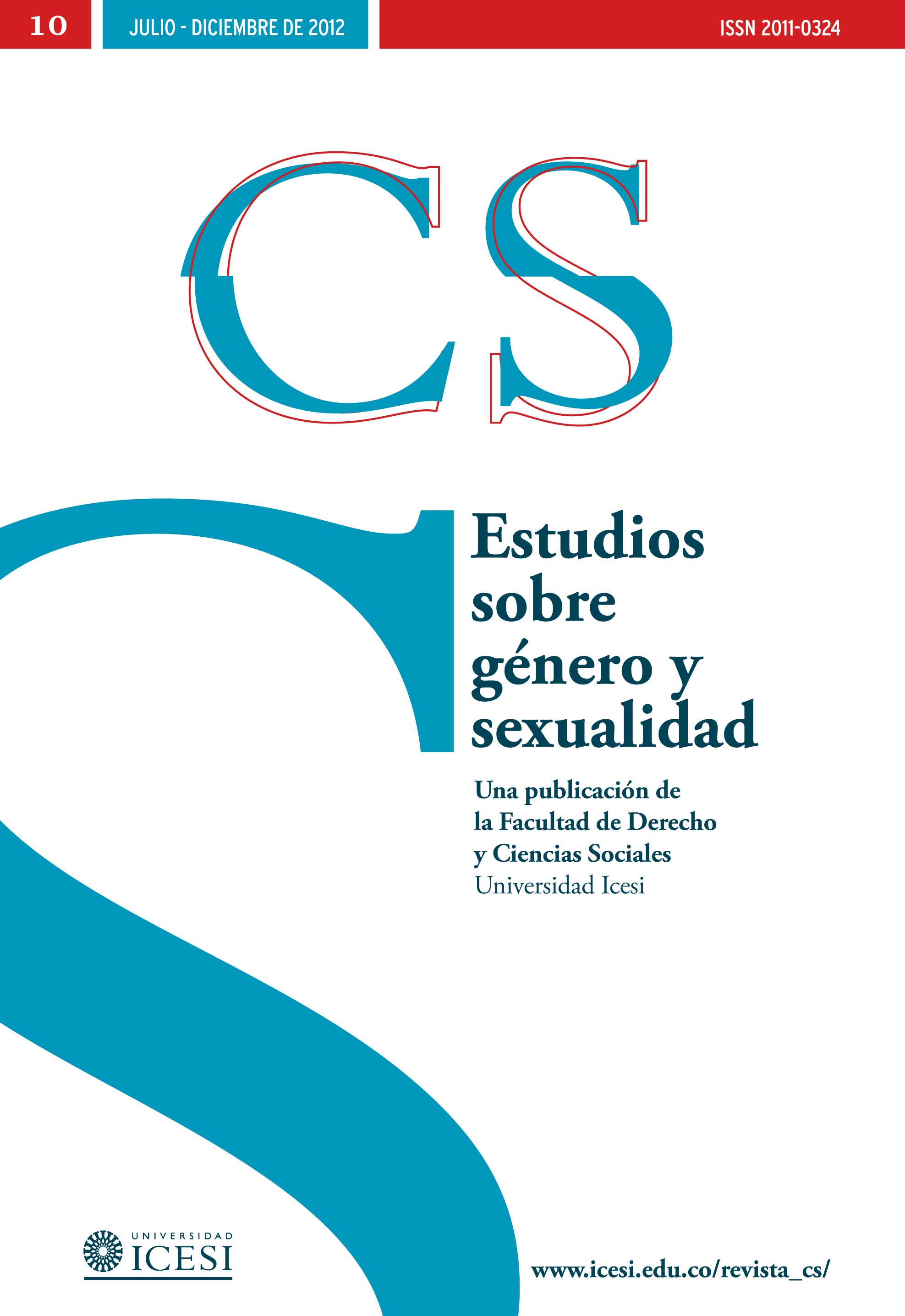Performatividad y lenguaje de odio: expresiones de la homosexualidad masculina en la ciudad de Cali
DOI:
https://doi.org/10.18046/recs.i10.1359Palabras clave:
Lenguaje de odio, Homosexualidad, Acto performativo, Deconstrucción, AlegoríaResumen
Este documento analiza los discursos de siete varones autorreconocidos como homosexuales en la ciudad de Cali en los que se refieren a la visibilización de la homosexualidad y sus consecuencias. Se toma distancia de la posibilidad de explicar dichos discursos a partir de una 'homofobia interna' o de una práctica de 'endodiscriminación', y se recurre al análisis performativo propuesto por la filósofa norteamericana Judith Butler, basado en tres categorías de análisis: alegorías, reglas (explícitas e implícitas) y deseo/aversión. A partir del análisis de las afirmaciones de los participantes, se concluye que el lenguaje de odio es una sucesión de actos performativos que constituye sujetos idealizados, a la vez que reafirma una masculinidad deseada pero amenazada, que permite defenderse de la supuesta persecución de la abyección sexual que amenaza la heteronormatividad, y que también da rienda suelta a un fuerte componente de deseo homoerótico inmerso en tales discursos.
Descargas
Referencias
Alarcón, A. (2008). Qué posee de 'queer' tiene la autobiografía areniana Antes que anochezca?. Neophilologus, 92 (4), 641–649.
Arenas, R. (1992). Antes que anochezca. Barcelona, España: Tusquets.
Arias de la Canal, F. (2002). Antología de la poesía homosexual y cósmica de Shakespeare. México D.F., México: Frente de Afirmación Hispanista.
Asociación Internacional de Gays y Lesbianas, ILGA. 2011. Portal online, disponible en http://ilga.org
Bourdieu, P. y Passeron, J. C. (1970). La reproducción. Elementos para una teoría del sistema de enseñanza. Madrid, España: Popular.
Butler, J. (1995). Conscience doth make us subjects of us all. Yale French Studies, 88, 1995, 6–26.
Butler, J. (2004). Precarious Life. The powers of Mourning and Violence. New York, USA: Verso.
Butler, J. (2005). Lenguaje, poder e identidad. Madrid, España: Síntesis.
Butler, J. (2005a). Giving an Account of Oneself. New York, USA: Fordham University Press.
Butler, J. (2009). Frames of War. When Life is Griefable?. New York, USA: Verso.
Butler, J. y Spivak, G. (2007). Who Sings the Nation – State?. New York, USA: Seagull.
Butler, J., Habermas, J., Taylor, C. y West, C. (2011). The Power of Religion in Public Sphere. New York, USA: Columbia University Press.
Castelar, A. (2008). 'La identidad en disputa. Una propuesta filosófica de Judith Butler', Tesis de Maestría en Filosofía, Universidad del Valle.
Castelar, A. (2010). Familia y homoparentalidad: una revisión de tema. Revista CS, (5), 45–70.
Eribon, D. (2004). Una moral de lo minoritario. Barcelona, España: Anagrama.
Fernández, F. (2004). '¿Hombres de verdad?' Estereotipo masculino, relaciones entre los géneros y ciudadanía. Foro Interno, (4), 15–43.
Foucault, M. (1975). Vigilar y castigar. El nacimiento de la prisión. México D.F., México: Siglo XXI.
Foucault, M. (1977). Historia de la sexualidad. México D.F., México: Siglo XXI.
Freud, S. (1913). Tótem y tabú. En Obras Completas. Tomo XIII. Buenos Aires, Argentina: Amorrortu.
Freud, S. (1925). La negación. En Obras Completas. Tomo XIX. Buenos Aires, Argentina: Amorrortu.
Gómez, F. (2011). La sexualidad de los angelitos. Arcadia, (69), 16–17.
Gómez, M.M. (2007). Violencia, homofobia y psicoanálisis: entre lo secreto y lo público. RES, (28), 72–85.
Granados, A. (2005). 'Ser gay es de machos. Prejuicio social y comportamiento gay – Etnografía en el bar Maraka de la ciudad de Cali', Tesis en Trabajo Social, Universidad del Valle.
Kaminsky, A. (2008). Hacia un verbo queer. Revista Iberoamericana, 74 (225), 879–895.
Kimmel, M. (1994). Masculinity as Homophobia. Fear, Shame and Silence in the Construction of Gender Identity. En H. Brod y M. Kaufman (Eds.), Theorizing Masculinities. Thousand Oaks, USA: Sage Publications.
Manrique, J. (2000). Maricones eminentes: Arenas, Lorca, Puig y yo. Barcelona, España: Síntesis.
Mora, D. (2002). La teoría de las representaciones sociales de Serge Moscovici. Athenea Digital, (2). Consultado en octubre de 2010 en: http://psicologiasocial.uab.es/athenea/index.php/atheneaDigital/article/.../55/5
Moreno, C. (2009). 'Lugares de encuentro gay en Cali: bares, restaurantes y discotecas', Tesis de grado en Geografía, Universidad del Valle.
Portal MediaIte. Michel Bachman, Gay Rights and the Role of Faith in Politics. Consultado en septiembre de 2011 en: http://www.mediaite.com/online/michele–bachmann–gay–rights–and–the–role–of–faith–in–politics/
Quintero, F. (2011). 'Representaciones sociales de la masculinidad en 10 hombres homosexuales de la ciudad de Cali', Tesis de grado en Psicología, Pontificia Universidad Javeriana.
Salazar, A. (1995). 'Nictálopes al encuentro de otro que es un yo. Sociografía de los lugares para hombres gay en Cali', Trabajo de grado en Sociología, Universidad del Valle.
Sancho, A. et al. (2009). Una investigación narrativa en torno del aprendizaje de las masculinidades en la escuela. Revista mexicana de investigación educativa, 14 (43), 1155–1189.
Sierra, A. (2008). Una aproximación a la teoría queer. El debate entre la libertad y la ciudadanía. El Ateneo de La Laguna, (26). Consultado en septiembre de 2012 en: http://www.ateneodelalaguna.es/pdf/ATENEO26/aprox.pdf
Viteri, M.A., Serrano, J. y Vidal – Ortiz, S. (2011). ¿Cómo se piensa lo queer en Latinoamérica?. Íconos, (39).
Yao, E. 'Un diputado italiano compara la homosexualidad con el canibalismo', Dosmanzanas, 2011. Consultado en septiembre de 2011 en: http://www.dosmanzanas.com/2011/09/diputado–italiano–compara–la–homosexualidad–al–canibalismo.html
Publicado
Número
Sección
Licencia
Derechos de autor 2012 Andrés Felipe Castelar, Felipe Quintero Aguirre

Esta obra está bajo una licencia internacional Creative Commons Atribución-NoComercial 4.0.
© Derechos reservados de autor
El material de esta publicación puede ser reproducido sin autorización, siempre y cuando se cite el título, el autor y la fuente institucional.
El contenido publicado en Revista CS se distribuye bajo la licencia Creative Commons BY-NC 4.0 Atribución/Reconocimiento-NoComercial 4.0 Internacional.
Usted es libre de:
Compartir — copiar y redistribuir el material en cualquier medio o formato.
Adaptar — remezclar, transformar y construir a partir del material.
Bajo los siguientes términos:
Atribución — Usted debe dar crédito de manera adecuada, brindar un enlace a la licencia, e indicar si se han realizado cambios. Puede hacerlo en cualquier forma razonable, pero no de forma tal que sugiera que usted o su uso tienen el apoyo de la licenciante.
NoComercial — Usted no puede hacer uso del material con propósitos comerciales.












